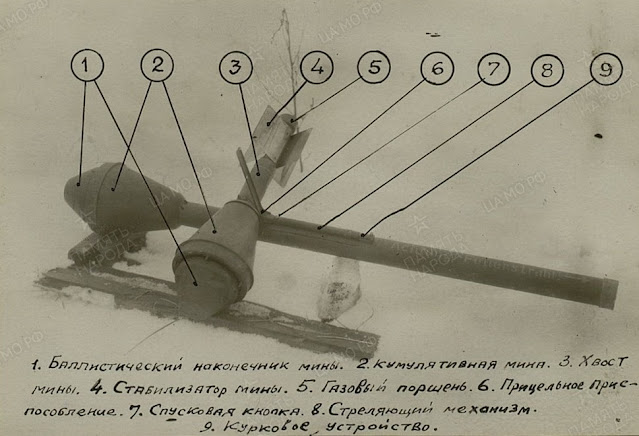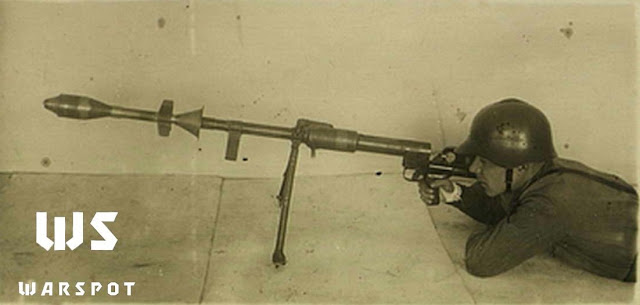The First Soviet RPG
Widespread use of anti-tank rocket launchers by both the USSR’s allies and enemies starting in 1943 forced it to expedite experimental work on these weapons. The first positive results were achieved in early 1944.
First steps
The Soviet military did not see value in light anti-tank rocket launchers at the start of the war. Their function was fulfilled by PTRD and PTRS anti-tank rifles. Light and maneuverable anti-tank weapons of the future would use either a more powerful 14.5 mm cartridge or a 20 mm caliber.
The first requirements for a large caliber man-portable anti-tank rocket launcher were issued by the GAU on December 11th, 1942. This weapon was expected to penetrate 50 mm of armour at an angle of 60 degrees from 400 meters. The weight of the system was limited to 12 kg. The weapon had to be able to fire with the shooter lying down, kneeling, or standing. With the exception of Ostrovskiy’s heavy anti-tank rifle, there is no information of anyone working on such a weapon in 1943.

“Faustpatrone” HEAT warhead launcher.
The sudden acceleration of work on anti-tank rocket launchers in early 1944 in the USSR was caused by the appearance of new German antitank weapons: the single shot Faustpatrone and multi-use Ofenrohr. Detailed instructions on the design and usage of German anti-tank rocket launchers were distributed in January of 1944. On January 31st the GAU Artillery Committee gave orders to develop new powerful short rangee anti-tank weapons.
Kazanovich’s group
The NIPSMVO (Small Arms and Mortar Research Proving Grounds) carried out trials of American, German, and British anti-tank warheads. The German ones proved the most capable, penetrating 180-230 mm of armour. Simple copying of foreign designs with use of substitute materials resulted in a considerable drop in penetration. A special group of engineers was formed at the NIPSMVO consisting of Gribakin, Boroshnev, Lominsky, and Renberg, led by Kazanovich. They began designing a new Soviet RPG from scratch.
The first stage of work took place between February 5th and April 12th, 1944. Trials showed that using a milled funnel rather than a welded one gave a better effect. A mix of TNT and cyclonite called TG-50 was chosen as the optimal explosive charge. The best results were given by a charge located at the top of the funnel. There was not a lot of time to experiment further. Soviet designers selected a shape with a cylindrical tip and truncated cone shape in the rear with a 1:1 tapering ratio. Experiments carried out at the Gorohovets Artillery Research Proving Grounds (ANIOP) in 1942-43 showed that funnel walls 2 mm thick gave the best results. Two types of ammunition were prepared, 70 and 90 mm in caliber with 150 and 200 mm of penetration respectively.
The design of the launcher was also worked out. One of the variants was the conversion of a PTRD with a worn out barrel. Another design, one resembling a recoilless rifle, was much more conventional. The result of this work was three variants of the launched indexed A, B, and V.

Firing from the A type launcher, 1944.
The A type launcher consisted of a converted PTRD with a shortened barrel, relocated bipod and handle, and new sights. The stabilizer for the warhead consisted of a smooth pipe with six fins. The 70 mm supercaliber grenade was fired by a 14.5 mm blank round filled with P-45 gunpowder.
The B type launcher consisted of a pipe open at both ends with a simple sight and trigger mechanism. The same supercaliber grenade used in the A type system was used, but with a 4-finned ring stabilizer and an additional black powder propellant charge. The V type launcher only differed from the B type in the size of the warhead it fired.
Comparative trials of domestic and foreign launchers showed that “they not only match foreign weapons with a similar purpose, but also surpass them in penetration, caliber, and weight”.

Firing the B type launcher while standing.
After more than two months of work, conclusions of the proving grounds dated April 12th, 1944, read:
" 1. The grenades and grenade launchers tested are powerful anti-tank infantry weapons that can combat armoured targets with up to 200 mm of armour inclusive at ranges up to 150 m.
- These designs have significant advantages over analogous weapons used by enemy and allied armies (Ofenrohr, Panzerfaust, Pz.B.39, American 60 mm launcher, British PIAT) both in combat effectiveness and economical/production factors.
- It is sensible to produce a pilot batch of launchers and grenades to conduct wide scale proving grounds and battlefield trials.
- It is sensible to create an 80 mm grenade based on the more effective 70 mm grenade, preserving its optimal parameters. Produce a test batch of 250-300 units for comparative trials of 80 mm and 90 mm grenades."
A light rocket launcher for infantry
A set of 660 pages of blueprints for all three launchers split into 40 albums was ready in April of 1944. The new documentation gave the type A launcher the name PTG-44, its projectile was indexed AKG-70. The B type launcher became LPG-70, ands projectile became the RKG-70. The V type launcher was named TPG-90 and its grenade the RKG-90.
The People’s Commissariat of Ammunition (NKV) factory #143 polished the designs and produced a test batch of warheads from June to August. Trials showed that penetration was stable at 150 mm at 100 meters. Due to "significant and sudden recoil when firing and small range" the PTG-44 launcher was rejected by military trials. Only the improved version of the LPG-70 reached large scale proving grounds and military trials in 1945. This happened after Germany surrendered. GOKO degree 8668ss issued on May 19th, 1945, ordered factory #2 to produce 500 launchers and factory #846 to produce 11,000 warheads. Trials were held at the NIPSVMO from August 29th to September 11th, 1945, led by Senior Technician-Lieutenant Lominskiy.

Firing the LPG-44 rocket launcher standing,
15 launchers produced at factory #2, 970 rockets produced at factory #846 and armed at factory #11 were tested. The LPG-44 light infantry rocket launcher had few differences from its predecessor, preserving almost all of its characteristics. It was mostly the GK-70 grenade that was improved, as the original had issues with the fuse. The inertial fuse was an improved version of the VKG-40 grenade fuse designed at GSKB-30.
The LPG-44 could be fired while standing, held either over the shoulder or under the arm, while kneeling, or prone. To fire, the fuse was inserted into the rear of the rocket, then the rocket was inserted into the launcher. The shooter armed the launcher by pulling the firing mechanism back. Trials showed that this procedure resulted in a practical rate of fire of 9-12 RPM.
The penetration of the GK-70 rocket was measured to be 150 mm both during bench trials against plates and live fire trials at a Tiger tank. Bench trials showed that the results were lower than those obtained using rockets assembled at the NIPSVMO. Firing at 25, 50, and 75 mm plates resulted in 100% penetration. When the rocket hit the tank’s front armour, penetration was achieved in every case, and in some cases hits resulted in ignition of the oil in the sump, destruction of the gun’s elevation mechanism, and jamming of the turret. However, testers noted inconsistent quality of rockets and unstable penetration.
Trials also showed that the trigger mechanism was fouled with gunpowder residue after 15-30 shots, which resulted in misfires and the trigger jamming. In total, 691 rocket out of 750 worked normally. In addition to failures to fire on impact or ricochets, there were also cases where the rocket did not fire at all. The primer could be inserted too far or not far enough, which made the rocket impossible to fire. 7.9% misfires sounds like a lot, but in most cases the issue could be corrected on the spot.

Firing the LPG-44 rocket launcher while kneeling, 1945.
The conclusions stated that the LPG-44 light anti-tank rocket launcher and the GK-70 HEAT rocket "passed proving grounds trials and can be considered a reliable and effective method of combat against armoured targets at close range, with characteristics no worse than any known foreign weapon of similar purpose". The defects and drawbacks of the weapon given in the NIPSMVO final report were to be corrected.
Still first
The rocket launcher improved in 1946 by designers of the Project Design Bureau of factory #2 (PKB-2) in Kovrov had wooden pads to protect the shooter from the barrel, which heated up if the weapon was fired rapidly. A brief manual of operation was produced in 1947, and in 1948 the GAU Artillery Committee finally approved the RPG-1 and PG-70 blueprints, giving them the index 56-G-661 and 57-GK-661 respectively.
The rest of the RPG-1’s fate is not completely known. There is no information about official acceptance into service or entry into production. The similar system designed by GSKB-30 seemed more promising around this time, and in 1949 they were accepted into service as the RPG-2 launcher and PG-2 rocket. Mass production began at factory #575 in Kovrov in the 1950s.
Characteristics of early Soviet RPGs:
| AKG-70 | LPG-70 | TPG-90 | LPG-44 | RPG-2 | |
|---|---|---|---|---|---|
| Launcher caliber, mm | 26 | 30 | 45 | 30 | 40 |
| Length, mm | 1250 | 1000 | 1200 | 1000 | 950 |
| Weight, kg | 13.5 | 2.0 | 3.5 | 2.0 | 2.75 |
| Grenade caliber, mm | 70 | 70 | 90 | 70 | 80 |
| Grenade weight, kg | 1.4 | 1.45 | 2.3 | 1.6 | 1.62 |
| Propellant weight, g | 9 | 70 | 110 | 70 | 220 |
| Muzzle velocity, m/s | 58.2 | 43.8 | 35.5 | 40 | 84 |
| Maximum range of aimed fire, m | 150 | 100 | 75 | 75 | 150 |
| Penetration, mm | 170 | 170 | 200 | 150 | 200 |











